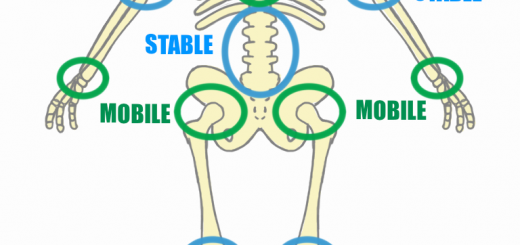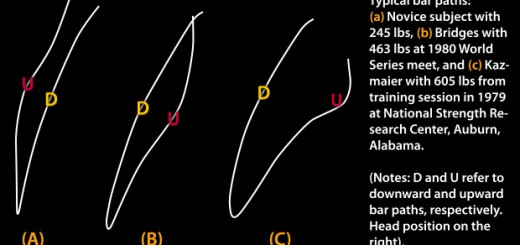- You’re a soft-handed newbie who hasn’t yet had the chance to build up thicker skin on your fingers and palms to protect them from tearing, or
- You’re not giving your hands the T.L.C. they need to keep from getting shredded.
Torn skin is painful and annoying, and may put you out of commission for a spell. And THAT is unequivocally un-hardcore.
My first encounter with shredded hands occurred shortly after starting CrossFit, back when the roughest activity my hands saw was an occasional difficult-to-open jar of spaghetti sauce. And my latest (and greatest) rip was during yesterday’s Mary WOD, after neglecting proper hand care for weeks. Over the past year, I’ve experienced minor tears and major ones. In this post, I’m going to discuss what I could (and should) have done to prevent bloody hand, and what treatment options are available to those of us unfortunate enough to gash open our hands doing high-rep pull-ups, kettlebell snatches and the like.
Hand Grooming
Those who are new to gymnastics, weightlifting or CrossFit in general often start with soft, callus-free hands. Ideally, to reduce the likelihood of hand tears, beginners should try to gradually build up calluses (through — what else? — handling bars) to the point where the skin on their palms and fingers are tough and thick — but smooth. Once some skin-thickening is achieved, the goal is to keep any calluses filed down. The goal is have a consistent, smooth palm surface, without noticeable ridges or fluctuating thicknesses of skin. A raised, rough callus will eventually blister and tear away from the surrounding skin, ripping open your hands and making a bloody mess. A general rule of thumb: If you can pinch a raised edge of the callus, it needs to be filed down. Constant vigilance and regular hand care is key to preventing tears.
You can use a number of different tools to keep your calluses in check, including:
- A nail file;
- A callus/corn shaver;
- Cuticle scissors;
- A pumice stone;
- A dull razor blade;
- Sandpaper;
- A butter knife; or
- A Dremel tool(!)
As one CrossFit Journal article put it:
Ideally, your entire palm surface should be one thick callus with no bumps or ridges in any one particular area. In order to do this, groom your hands always after a hot shower or bath (this allows the calluses to swell up). While the calluses are still “swollen,” I take a double-edged razor and very carefully shave the dead callus bumps down a little at a time until the bumps are about even with the thickness of the rest of the hand. With my younger students, I simply ask them to get a callus stone (you can buy one at any drug store), and gently sand the callus down even with the rest of the skin. Remember, whenever you groom or shave your calluses, don’t overdo it, since you don’t want to go too deep into your skin. Always leave enough thick skin so to facilitate your workout the following day. The goal is to maintain an even and consistent thickness of hard skin throughout the entire palm.
Also: Lube up your hands. Chalk and frequent washing will suck the moisture right out your skin, and dry, cracked hands do not feel awesome. So listen to the Silence of the Lambs guy: Lotion is important for skin care. (And remember to put the lotion in the basket.) Use Bag Balm or Udder Cream (it’s not just for irritated cows anymore!) or whatever suits your fancy.
This, by the way, is what a well-groomed pair of CrossFitting hands is supposed to look like:
My hands don’t look like this. Being the idiot that I am, I’ve never been very consistent about filing down my calluses, and lately, I developed a few big ones with rough edges. I didn’t do anything about ‘em, and as a result, I tore ‘em wide open yesterday. Not fun.
Grip & Technique
A lot of CrossFitters rip open their hands doing high-rep bar movements: kipping pull-ups, clean-and-jerks, snatches. But there are ways to tweak your technique to reduce the chances of a nasty tear.
First, use the right grip.
When working with a barbell, some folks are inclined to grip the bar across the middle of their palms. This, unfortunately, squishes the fleshy pad below the base of your fingers against the bar, causing discomfort, added friction, blisters, and worse. A better way to go is to grip the barbell across the base of your fingers — where the metacarpals meet the proximal phalanges. Check out Mark Rippetoe’s explanation of how to grip a bar properly:
As for doing kipping pull-ups while training (versus competing), CrossFitter Pär Larsson has this to say about getting a proper grip:
When doing pull-ups, keep your metacarpals in line with your proximal phalanges; i.e., your hand bones and the first bones in your fingers. This sucks because it’s harder to do pull-ups with your center of gravity an inch lower, and it takes more finger/ forearm strength. The first week or two or five, you might have to go back to using a band sometimes, or doing jumping pull-ups on a box, or using an easier band. I understand this might hurt your pride, your ego and your self-esteem like it did mine, but as long as I get the workout I need I see no need to care much if I beat my friends in an everyday training environment… Plus, I don’t have to worry about caring for ripped and bleeding hands.
As Larsson points out, “[t]his “training grip” eliminates tons of friction on the top inside of your palm muscles and skin, which is what causes the ubiquitous blisters there.” Friction is further reduced if you keep your core tight during kipping pull-ups, keeping your movement compact.
For example, in this GymnasticsWOD video (which Tim posted on theCrossFit Palo Alto Facebook page yesterday), Carl Paoli doesn’t engage in the exaggerated lateral swing that many of us are used to doing. Notice the efficiency of movement; his legs aren’t kicking violently out front. He doesn’t flop around. By keeping the kipping motion short and focused, there’s less of the skin-on-bar rubbing that might lead to shredded hands.
Lesson: Huge kips lead to torn hands.
Treatment
At a barbecue yesterday, I got to talking with Trish about her recent experiment with different ways of treating shredded hands. She’d ripped up her skin in a number of places during Memorial Day Murph, and decided to treat each tear slightly differently:
- With Rip No. 1, she used scissors to cut away the flap of skin.
- With Rip No. 2, she tore the skin flap off by tugging on it away from the point at which the skin was still attached.
- And with Rip No. 3, she just left the flap in place.
All three spots were slathered with antibacterial ointment and bandaged. According to Trish, Rip No. 3 healed fastest. “It was like having a natural Band-Aid in place,” she said. Interestingly, Rip No. 1 — the one subjected to the scissors — was slowest to heal.
I’m now conducting a similar experiment. On my right hand, I’ve used scissors to snip off the flap of skin that tore away from my hand; on my left, I’ve left the skin in place. Of course, I washed both hands carefully (OUCH), Neosporin-ed the heck out of them, and kept ‘em bandaged and dry. I’ll report back on the results in a few days.
But regardless, I know this much: It’s important to clean the wound and keep it well-covered with antibacterial ointment to prevent infection. No one wants a staph infection or necrotizing fasciitis.
I’m using Neosporin, but there are, of course, lots of other remedies that people swear by, including:
Gloves, Grips & Tape
I know what you’re thinking: It’s a pain in the ass to keep your hands from ripping, and treating them sounds less than fun, too — so why not just slap on a pair of gloves?
The folks over at CrossFit Impulse point to two compelling reasons to train without gloves:
- “[U]nless you wear gloves throughout your daily life, at some point you will have to rely on the pure, unadulterated gripping power of your bare-skinned hands to perform work,” so “develop[] that capability into your own hands as much as possible.”
- “[A]nything between your hands and the object you are gripping reduces your proprioception — your ability to know where the object is in space relative to your body.”
Not everyone agrees with this assessment, of course. Some athletes fiercely defend the use of gloves, arguing that the prevention of injury trumps the benefits of going glove-free. And Reebok has developed CrossFit gloves (available in the CrossFit HQ store) that numerous athletes wore during Games. But then again, they were in competition — and did as many as TEN workouts (many with high-rep bar movements) over the course of a single weekend. Their hands were trashed. So before you rush out to plunk down forty bucks for a pair of fancy new gloves to bring to your gym, ask yourself whether they’re warranted. If your hands aren’t wrecked, you probably don’t need gloves.
Similarly, grips and tape aren’t normally needed in CrossFit. If you’re a gymnast, grips will certainly allow you to train harder and longer, but if you’re just cranking out a quick metcon, you’re unlikely to need to ‘em on a regular basis.
However, when your hands are already torn or if you know the day’s WOD is likely to destroy your skin, pulling out the athletic tape may be just the thing to keep you from a world of hurt. Plus, a few strips of tape are unlikely to be as heavily (and unnecessarily) padded as a big pair of mittens.
Right now, my hands are ripped up, and I can’t easily grip anything without covering the places where my skin has been torn away. So tomorrow morning, I’m going to grab a roll of athletic tape and cover the spots that need protection. I’ll also make a handy-dandy tape-grip for additional protection. If you love origami and want to get all fancy, check out these step-by-step instructions for making a super-slick grip out of athletic tape.
And if you just want to quickly throw on a makeshift tape grip before your WOD starts, you can always do this instead:
- Grab a roll of athletic tape (the 1.5-inch tape works great).
- Tear off a strip that’s a few inches longer than your hand.
- Split the strip lengthwise down the middle until you’re halfway down.
- Stick the unsplit half of the tape on your palm (over the rip), with the split ends wrapping around either side of the finger above the rip.
- Use additional tape as needed to secure the ends of the tape around your wrist and around your finger.
- Go kick some butt.
Want more info on hand care? Check out CrossFit Virtuosity’s four-part series on how to take care of your mitts.
Okay — that’s all I got. If you have other tips and tricks, throw ‘em in the comments section — given the current state of my hands, I’m certainly motivated to try them out.













